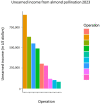Case Report: Emerging Losses of Managed Honey Bee Colonies
- PMID: 38392335
- PMCID: PMC10887003
- DOI: 10.3390/biology13020117
Case Report: Emerging Losses of Managed Honey Bee Colonies
Abstract
United States commercial beekeepers prepare honey bee colonies for almond pollination in California each year in late January to early February. This represents the largest managed pollination event in the world and involves more than half of all U.S. honey bee colonies. In winter 2023, numerous colonies in Florida, which were graded as suitable for almonds (larger than ten frames of bees), dwindled suddenly or altogether died within several weeks, just prior to movement for almonds. The timing of these losses and the resulting morbidity caused severe economic harm to affected operations. This study reports interviews with affected stakeholders, their economic harm, and analyses of pathogens and parasites found in their colonies.
Keywords: agricultural pests; collapse; economic harm; honey bees; parasites; pathogens.
Conflict of interest statement
The authors declare that they have no competing interests.
Figures




References
-
- Kulhanek K., Steinhauer N., Wilkes J., Wilson M., Spivak M., Sagili R.R., Tarpy D.R., McDermott E., Garavito A., Rennich K., et al. Survey-derived best management practices for backyard beekeepers improve colony health and reduce mortality. PLoS ONE. 2021;16:e0245490. doi: 10.1371/journal.pone.0245490. - DOI - PMC - PubMed
-
- Watters J.K., Biernacki P. Targeted sampling: Options for the study of hidden populations. Soc. Probl. 1989;36:416–430. doi: 10.2307/800824. - DOI
-
- Calderone N.W., Turcotie R.M. Development of Sampling Methods for Estimating Levels of Varroa jacobsoni (Acari: Varroidae) Infestation in Colonies of Apis mellifera (Hymenoptera: Apidae) J. Econ. Entomol. 1998;91:851–863. doi: 10.1093/jee/91.4.851. - DOI
Publication types
LinkOut - more resources
Full Text Sources

